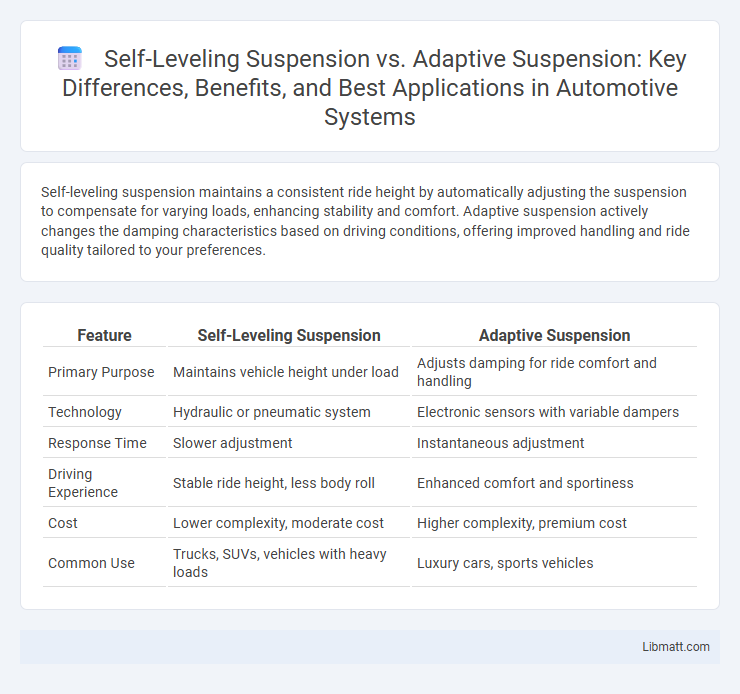Self-leveling suspension maintains a consistent ride height by automatically adjusting the suspension to compensate for varying loads, enhancing stability and comfort. Adaptive suspension actively changes the damping characteristics based on driving conditions, offering improved handling and ride quality tailored to your preferences.
Table of Comparison
| Feature | Self-Leveling Suspension | Adaptive Suspension |
|---|---|---|
| Primary Purpose | Maintains vehicle height under load | Adjusts damping for ride comfort and handling |
| Technology | Hydraulic or pneumatic system | Electronic sensors with variable dampers |
| Response Time | Slower adjustment | Instantaneous adjustment |
| Driving Experience | Stable ride height, less body roll | Enhanced comfort and sportiness |
| Cost | Lower complexity, moderate cost | Higher complexity, premium cost |
| Common Use | Trucks, SUVs, vehicles with heavy loads | Luxury cars, sports vehicles |
Introduction to Vehicle Suspension Systems
Vehicle suspension systems are critical for enhancing ride comfort and handling by absorbing shocks from road irregularities. Self-leveling suspension automatically adjusts the vehicle's ride height to maintain a consistent level regardless of load, ensuring stability and optimal tire contact. Adaptive suspension uses sensors and electronic controls to continuously adjust damping rates in real-time, providing a customizable balance between comfort and performance based on driving conditions.
What is Self-Leveling Suspension?
Self-leveling suspension automatically adjusts the vehicle's ride height to maintain a constant level regardless of load weight, enhancing stability and comfort. It uses sensors and hydraulic or air systems to raise or lower the chassis, compensating for uneven terrain or heavy cargo. This technology is commonly found in SUVs, trucks, and luxury vehicles to optimize handling and prevent sagging.
What is Adaptive Suspension?
Adaptive suspension is an advanced vehicle suspension system that continuously adjusts the damping force of each shock absorber in real time based on driving conditions, road surface, and driver inputs. Utilizing sensors and electronic control units, it optimizes ride comfort and handling by altering stiffness and responsiveness dynamically. This technology enhances vehicle stability, improves traction, and delivers a smoother driving experience compared to traditional self-leveling suspension systems.
Key Differences Between Self-Leveling and Adaptive Suspension
Self-leveling suspension maintains a constant ride height by automatically adjusting to changes in load, ensuring stability and comfort during varying weight conditions. Adaptive suspension, however, continuously adjusts damping settings in real-time to optimize ride quality and handling based on road conditions and driving style. Your choice depends on whether you prioritize consistent ride height or dynamic ride adaptability for enhanced driving performance.
Performance Impact: Comfort and Handling
Self-leveling suspension enhances performance by maintaining a constant ride height regardless of load, improving stability and comfort during varying conditions. Adaptive suspension dynamically adjusts damping rates in real-time, optimizing both comfort and handling by responding to road surfaces and driving styles. The combination of consistent vehicle posture and responsive shock absorption results in superior ride quality and precise control.
Technology and Components Involved
Self-leveling suspension uses sensors and hydraulic or air systems to maintain a constant ride height by automatically adjusting to load changes, enhancing stability and comfort. Adaptive suspension relies on electronically controlled shock absorbers with sensors that continuously monitor road conditions and driving dynamics to adjust damping rates in real-time. Your choice depends on whether you prioritize consistent ride height or dynamic handling adjustments based on terrain and driving style.
Cost Comparison and Maintenance Needs
Self-leveling suspension generally costs less upfront than adaptive suspension due to its simpler hydraulic or air-based systems, but it may require more frequent maintenance to ensure consistent performance. Adaptive suspension systems, equipped with electronic controls and sensors, carry a higher initial price and often involve more complex, costly repairs over time, yet they provide superior ride customization and handling. When choosing your suspension, consider not only the initial cost but also long-term maintenance expenses and how each system aligns with your driving needs.
Suitability for Different Vehicle Types
Self-leveling suspension is ideal for SUVs, trucks, and vehicles frequently carrying heavy loads as it maintains a consistent ride height by automatically adjusting the suspension. Adaptive suspension suits luxury cars and performance vehicles by offering variable damping that enhances ride comfort and handling based on driving conditions. Your choice depends on whether you prioritize load leveling for stability or dynamic ride quality for responsiveness.
Pros and Cons of Self-Leveling Suspension
Self-leveling suspension offers the advantage of maintaining optimal vehicle height and stability regardless of load, improving ride comfort and handling on uneven terrain. However, it may involve higher maintenance costs and complexity compared to traditional systems, with potential limitations in responsiveness during rapid driving conditions. Despite these drawbacks, self-leveling suspension enhances safety by preventing sagging and uneven tire wear, making it ideal for heavy-duty and off-road vehicles.
Pros and Cons of Adaptive Suspension
Adaptive suspension offers enhanced ride comfort and improved handling by automatically adjusting damping settings based on driving conditions, providing a smoother and more responsive experience. Your vehicle benefits from better stability during cornering and varying road surfaces, although the system can be more complex and costly to maintain compared to self-leveling suspension. However, adaptive suspension may also increase overall vehicle weight and reduce fuel efficiency due to its advanced components and electronic controls.
Self-Leveling Suspension vs Adaptive Suspension Infographic

 libmatt.com
libmatt.com